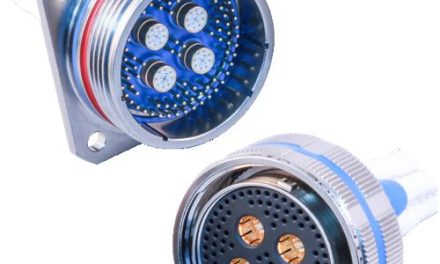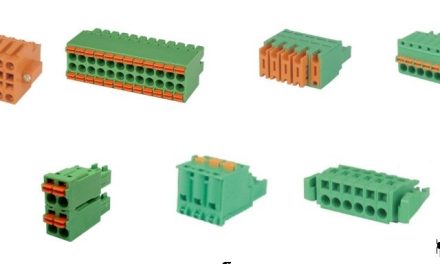 David Phillips, Managing Director of Binder UK, offers an insight into the growth in popularity of M16 connectors and how they are ‘driving’ forward.
David Phillips, Managing Director of Binder UK, offers an insight into the growth in popularity of M16 connectors and how they are ‘driving’ forward.
From humble origins in the audio industry some 50 years ago, the M16 connector has come a long way and has been the subject of many technical developments and refinements and is now incorporated into technology that touches almost everyone every day.
Unshielded M16 connectors, named after the mating thread size, were originally designed to meet the requirements of the Deutsches Institut für Normung that defined the standard for circular connectors for analogue audio signals.
Used widely for many years and commonly known in the audio industry and to the consumer as DIN connectors, the DIN standard was incorporated into a number of connector styles and specified the diameter, geometry of the mating face, the contact arrangements and the pin functions for 3, 5, 6, 7 and 8 pole connectors.
The original DIN standard has now been replaced by IEC 60130-9, ‘connectors for frequencies below 3MHz – for radio and associated sound equipment’ and although DIN connectors are still used they are now less popular in the face of other more prominent audio connector systems.
While still available in the original unshielded IP40 DIN formats, M16 connectors have advanced in all aspects when compared to the early audio versions.
Driven by the demand for lower contact resistance, higher pin count and improved levels of protection, almost anything is now possible with M16 connectors and versions are available with between two and 24 silver or gold plated contacts, with or without shielding from electromechanical interference (EMI) and with environmental protection up to IP67.
A wide range of alternatives are available for cable mounting with straight or right-angled connectors terminated by soldering or, more recently, with screw contacts. Pre-moulded cables are also available.
The options are just as comprehensive when it comes to the panel receptacles with front or rear fastening as standard for solder bucket versions and front-fastening for dip solder and pre-terminated flexible PCBs.
The versatility of this connector style along with the benefits of rugged design with good environmental resistance have seen the M16 used in instrumentation, measurement and sensors for both indoor and outdoor use where there is a need for a higher pin count than is offered by M8 and M12 sensor connectors.
 Other applications include pneumatic controls, gas and pressure measurement, torque sensors and motor speed regulators.
Other applications include pneumatic controls, gas and pressure measurement, torque sensors and motor speed regulators.
The combination of a high pin count with the compact size of nominally 18.5mm diameter and 60mm in length means M16 connectors offer an excellent alternative to more expensive connector systems.
Special short versions and right-angled versions with a height of only 37mm mean M16 can be used in applications where space is very tight.
For strength and ease of machining, connector bodies are turned from brass and are then plated with eight to ten microns of nickel for corrosion resistance and aesthetics.
For extreme environmental conditions rugged versions with a black chromate finish are produced and these are highly appreciated by manufacturers of CCTV equipment and automatic number plate recognition (ANPR) systems; used for security, barrier control, measuring traffic flow, checking the insurance, MOT and road tax status of vehicles; and, less popularly, for law enforcement by measuring the average speed of vehicles.
Contact carriers are manufactured from polybutylene terephthalate (PBT) for its insulating properties, excellent chemical resistance and good dimensional stability from -30ºC up to 95ºC.
Solder contacts for wires between 0.14mm2 (AWG 26) and 0.75mm2 (AWG 20) give a secure termination and excellent electrical properties for soldering at 370ºC/4s or 270ºC/10s, while for ease of wiring in-the field screw termination options have recently been introduced.
Copper alloys are the material of choice for contacts and ensure good strength, conductivity and temperature stability, brass being used for pins and phosphor bronze for socket contacts for its excellent spring capabilities.
Silver or gold plating of contacts provides over 500 mating cycles and low contact resistance of 5m2 for silver and 3m2 for gold make them particularly suitable for low voltage applications in the mA-range.
With increasing requirements from equipment manufacturers for shielding against EMI, more applications now require shielded cable systems with the requirement for connectors with good shielding characteristics included.
For optimum results 360º shielding is required and this is achieved by integral shielding rings, providing a high attenuation over a large frequency band.
This performance is used to good effect in UMTS (3G) mobile installations where cables fitted with M16 connectors meet the requirements of AISG v2.0 (Antenna Interface Standards Group) and are used to connect the base station to remote electrical tilt (RET) features of the antennas thus allowing the size of the mobile communications cells to vary and accommodate high call traffic.
Protection against dust and water ingress is rated at IP40 for the entry level connectors while the use of elastomeric seals and O-rings offer extended protection to IP67 versions with high levels of chemical resistance. Connectors with protection to IP68 can be supplied to individual customer specifications.
Of particular interest are pre-moulded connectors supplied already terminated on PUR jacketed cable with or without a shielding braid.
These are as used by manufacturers of ‘smart meters’ that are becoming the norm for utility companies who require shielding and good environmental protection and benefit from reading meters remotely.
Binder UK



